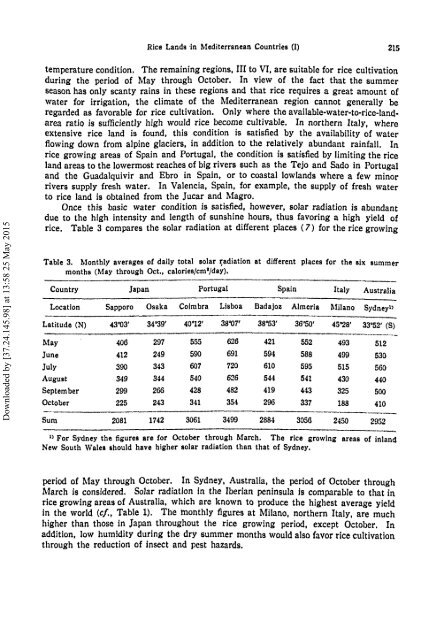Takaya et al. - 1974 - Rice cultivation and its environmental conditions
Takaya et al. - 1974 - Rice cultivation and its environmental conditions
Takaya et al. - 1974 - Rice cultivation and its environmental conditions
You also want an ePaper? Increase the reach of your titles
YUMPU automatically turns print PDFs into web optimized ePapers that Google loves.
<strong>Rice</strong> L<strong>and</strong>s ·in Mediterranean Countries (1) 215<br />
Downloaded by [37.24.145.98] at 13:58 25 May 2015<br />
temperature condition. The remaining regions, III to VI, are suitable for rice <strong>cultivation</strong><br />
during the period of May through October. In view of the fact that the summer<br />
season has only scanty rains in these regions <strong>and</strong> that rice requires a great amount of<br />
water for irrigation, the climate of the Mediterranean region cannot gener<strong>al</strong>ly be<br />
regarded as favorable for rice <strong>cultivation</strong>. Only where the available-water-to-rice-l<strong>and</strong>area<br />
ratio is sufficiently high would rice become cultivable. In northern It<strong>al</strong>y, where<br />
extensive rice l<strong>and</strong> is found, this condition is satisfied by the availability of water<br />
flowing down from <strong>al</strong>pine glaciers, in addition to the relatively abundant rainf<strong>al</strong>l. In<br />
rice growing areas of Spain <strong>and</strong> Portug<strong>al</strong>, the condition is satisfied by limiting the rice<br />
l<strong>and</strong> areas to the lowermost reaches of big rivers such as the Tejo <strong>and</strong> Sado in Portug<strong>al</strong><br />
<strong>and</strong> the Guad<strong>al</strong>quivir <strong>and</strong> Ebro in Spain, or to coast<strong>al</strong> lowl<strong>and</strong>s where a few minor<br />
rivers supply fresh water. In V<strong>al</strong>encia, Spain, for example, the supply of fresh water<br />
to rice l<strong>and</strong> is obtained from the J ucar <strong>and</strong> Magro.<br />
Once this basic water condition is satisfied, however, solar radiation is abundant<br />
due to the high intensity <strong>and</strong> length of sunshine hours, thus favoring a high yield of<br />
rice. Table 3 compares the solar radiation at different places ( 7) for the rice growing<br />
Table 3. Monthly averages of daily tot<strong>al</strong> solar ~adiatlon at different places for the six summer<br />
months (May through Oct., c<strong>al</strong>orles/cm 1 /day),<br />
Country Japan Portug<strong>al</strong> Spain It<strong>al</strong>y Austr<strong>al</strong>ia<br />
Location Sapporo Osaka Coimbra Llsboa Badajo~ Almeria Milano Sydney 1 l<br />
Latitude (N) 43•03' 34"39' 40°12' 38007' 38°53' 36"50' 45"28' 33•52' (S)<br />
May 406 297 555 626 421 552 493 512<br />
June 412 249 590 691 594 588 499 530<br />
July 390 343 607 720 610 595 515 560<br />
August 349 344 540 626 544 541 430 440<br />
September 299 266 428 482 419 443 325 500<br />
October 225 243 341 354 296 337 188 410<br />
Sum 2081 1742 3061 3499 2884 3056 2450 2952<br />
,, For Sydney the figures are for October through March. The rice growing areaa of inl<strong>and</strong><br />
New South W<strong>al</strong>es ehould have higher solar radiation than that of Sydney.<br />
period of May through October. In Sydney, Austr<strong>al</strong>ia, the period of October through<br />
March is considered. Solar radiation in the Iberian peninsula ls comparable to that in<br />
rice growing areas of Austr<strong>al</strong>la, which are known to produce the highest average yield<br />
in the world (cf., Table 1). The monthly figures at Milano, northern It<strong>al</strong>y, are much<br />
higher than those in Japan throughout the rice growing period, except October. In<br />
addition, low humidity during the dry summer months would <strong>al</strong>so favor rice <strong>cultivation</strong><br />
through the reduction of Insect <strong>and</strong> pest hazards.

















